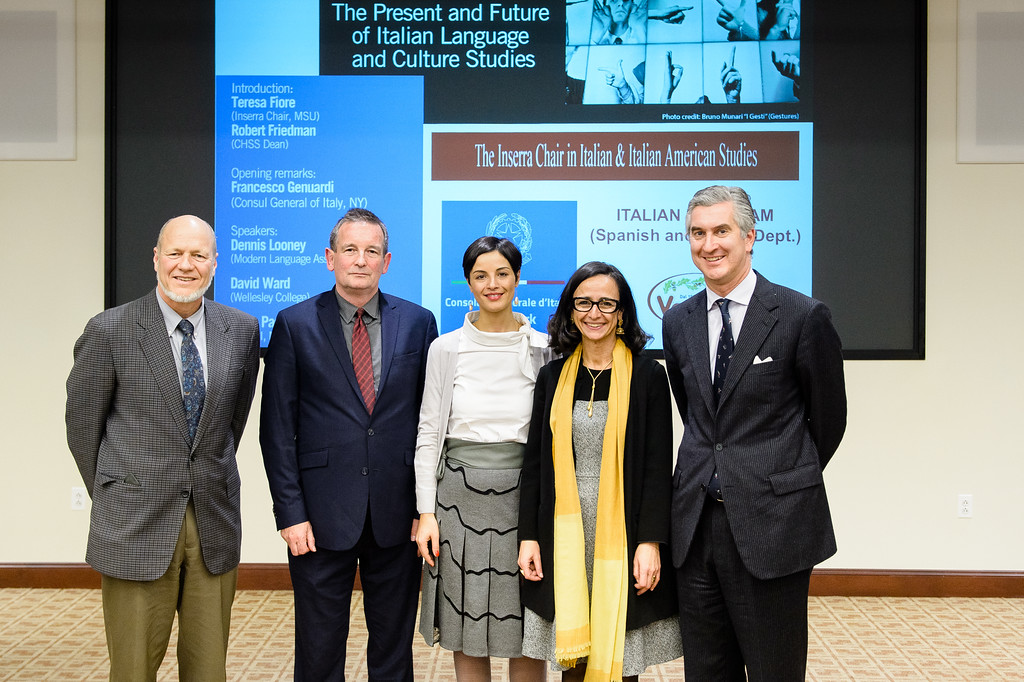LEGGI QUESTO ARTICOLO IN ITALIANO
Tuesday, November 15th, a conference on the Italian language entitled Come Sta L’Italiano? – How’s Italian Doing took place at Montclair University. The conference, promoted by the Inserra Chair in Italian and Italian American Studies, aimed to analyze the current situation of the Italian language in the United States and to suggest new plans for the future.
Speakers of the event were the experts Dennis Looney and David Ward, the Italian general consul of New York, Francesco Genuardi, and the new coordinator for the promotion of the Italian language abroad of the Minister of the Internal Affairs and International Cooperation, Lucia Pasqualini.

After a brief introduction on the position of Italian in the world and its identity abroad by Teresa Fiore, the Inserra Chair in Italian and Italian American Studies, and by the Italian consul, the speakers brought attention to various aspects of the Italian language.
Dennis Looney, director of the programs and ADFL Department and the Modern Language Association, addressed the situation of the languages in the world today. Looney explained how, after the Sixties, the world of modern languages, therefore the study of Italian as well, experienced a great decline. Even though Italian is not among the languages that suffered the most decline, the world of modern languages is facing a crisis. Looney expounded that American students are abandoning the study of languages in favor of more technical studies: a situation not ideal for the language of the Bel Paese (Italy). The professor demonstrated the utility of foreign language knowledge, not only as a personal enrichment, but also, and above all, in the work environment. In fact, the importance of Italian and languages in general in tourism, design, and in the fashion world, the industry of languages, of science, and technologies was at the center of his presentation.

Based on Looney’s studies, Professor David Ward, Chair of the Department of Italian Studies at Wellesley College, illustrated some of the new teaching methods for Italian, targeted to attract more students, and counter this “language crisis,” but also to offer a more effective language experience. The experts asked themselves: “How can we create new courses that can give justice to the richness of the Italian language and in the meantime keep up with the new technologies of the globalized world?.” The answer was provided by online courses. In 2014, thanks to the edX platform, Daniela Bartalesi, Ward’s colleague, was able to create and offer Italian online courses for all levels, from beginners to advanced, which had a great success. All learners enrolled in those courses can access the course in any place and from any device they want to, making, in this way, the process of learning easy and convenient. The Wellesley project is funded by MAECI to support italian chairs. Regarding 2017, more than 51,000 people are already enrolled in the courses. 1,300 are the in-campus courses (and many more are out-campus).Wards is convinced that the future of the Italian language lays in remote education.

Lastly, Lucia Pasqualini reported the success of the General States of the Italian Languages conference that took place this past October in Florence. Pasqualini was very satisfied with the results achieved by the event and of the extraordinary presence of both the major institutional offices of Italy, the prime minister, Matteo Renzi, and the president of the republic, Sergio Mattarella. Moreover, Pasqualini talked about the importance of the use of Italian culture and its international fame to attract more people towards the language, but also as a communication means to help the industrial sector and Italian companies. According to Pasqualini, Italian culture would be able to leverage on the public and increase the sale of products of Italian companies. Especially in the United States, the Italian culture and the Italian language have an important role. The goal is to use the popularity of Italian culture to attract and get more people passionate about the language, because learning a language also means to get to know a culture. As a representative for the promotion of the Italian language abroad, Pasqualini sees the future of Italian language in the creation of bilingual programs (for which she was a promoter in the first place when she was vice-consul in New York) and multilingual programs.
Even though Italian is facing a challenging phase, at the end of the conference there was a new sense of hope and especially of innovation in both the teaching and communicative methods. Responses in line with today’s world are already in place in order to protect the future of the Italian language outside of Italy. In the light of the facts illustrated during the conference, the answer to the question that gave the title to the event is that, after all, Italian is doing pretty well.
Watch a video presentation of the event:












